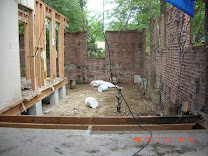In a previous post (
Snowman on Miami Beach) I recognized the influence of Dr. Norman Vincent Peale on my life and career. And while I was writing that one, I realized that Stephen Covey has been notably influential for me as well. In one of my part-time jobs during college, I borrowed an audio abridgment of Mr. Covey's top selling book,
The 7 Habits of Highly Effective People. I loved the lessons and the stories that drove the habits home and Mr. Covey was the voice teaching me on the tapes, so in a way it felt as if I got to know him personally as I listened. I soaked in every word of the 6 hour version while I worked and as I bounced around Cincinnati in my car. The tapes of the book just weren't just educational, I found the stories that accompanied them simultaneously entertaining and inspirational; a palatable mix. I probably listened to this collection of cassettes a dozen times or more.
 |
Stephen Covey
1932-2012 |
Fast forward two decades to me as a a self-employed home rehabber with a couple shows on TV and
a daughter in the fourth grade at Summerville Elementary. SES was a Leader In Me school which means the 7 Habits were an integral part of the curriculum. At SES, Covey's teachings had been woven into the lessons Tatiana learned throughout the school day. They were part of the school's décor in the hallways and classrooms, and in songs the children sang to help them learn and remember the habits. It was sweet and cute, but in my eyes, significant and this is when I realized how much the 7 Habits had become a part of my life. Somehow, I had forgotten the source but not the wisdom, yet I'd internalized these specific habits profoundly, so much so, that I had begun teaching them to my daughter without realizing or remembering where or how I'd learned them. So when I made this connection, I was instantly grateful that the SES Team would be helping me instill these fundamentals that had helped me be more
effective. From the beginning of my home renovation career, I have unconsciously applied Mr. Covey's 7 Habits. Here are a few examples:
1. Be Proactive - On my rehabs, Habit 1 is all about helping me work safely while I save time and money, by thinking ahead, trying to anticipate and avoid pitfalls before they might impact the project.
2. Begin with the End in Mind - One of the first steps on my project is to draw up a modified floorplan showing how I want the house to be when I'm finished. From this moment I start to picture in my mind how rooms will look on the inside and how the house will appear on the outside. From the beginning I have my "silk purse" in my mind's eye.
3. Put First Things First - Working in the proper sequence is critical on a rehab and on that first project, it really stressed me out. I worked hard to take on my project in proper order, but I messed more than a few things up, redid these scopes, and learned from the missteps. Habit 3 exemplifies the importance of doing the most urgent things first. It makes sense, but if you've ever watched an episode of Renovation Realities on DIY, you know that not every rehabber puts first things first. (I don't know if that show is still on, but it's awesomely hilarious with me feeling as if I'm often laughing at my past self.)
4. Think Win-Win - Habit 4 is essential to a successful project, especially when hiring contractors. A win-win attitude is a necessity for me, but I also want to hire people with this as a professional value. I want my contractors to make a profit and I want them to be onboard with my goal; transforming the house as planned and receiving my certificate of occupancy. Projects with win-win people are the safest and most profitable.
5. Seek First to Understand, Then to Be Understood - Again, in dealing with folks hired to help me get to the finish line of a rehab(the C.O.) it's helpful to apply habit 5 from the first meeting to the last check. I can ignore this, but this oversight will lead to mistakes and disagreements which ultimately cost time and waste money.
6. Synergize - This habit is recognition that other people are an asset that can help me finish quicker, and safer with the largest profit margin possible. I may think I know everything, but as the saying goes, two heads are better than one and if two people can be two and half times as productive, then capitalizing on the help from eight, ten, or or twenty experienced people makes the project better to a degree that's difficult to measure. Put another way, think of two people each lugging a sheet of plywood individually, versus two people carrying two sheets together. Team work makes the dream work and is an example of Habit 6.
7. Sharpen the Saw - I love what I do, but I have to remember to pull back to rest, exercise, and recharge. In addition, I need to be mindful of new trends in real estate design and be open to adjust my approach. And I don't renovate exactly how I did twenty years ago. I have a larger arsenal of tools and have learned techniques that I was oblivious to back when I started in 2000. This old dog has to constantly be willing to learn some new tricks to be safe, efficient, and competitive.
No matter who you are or what line of work you're in, the wisdom of the 7 Habits will be an asset to you and synergistically speaking, to those around you.












